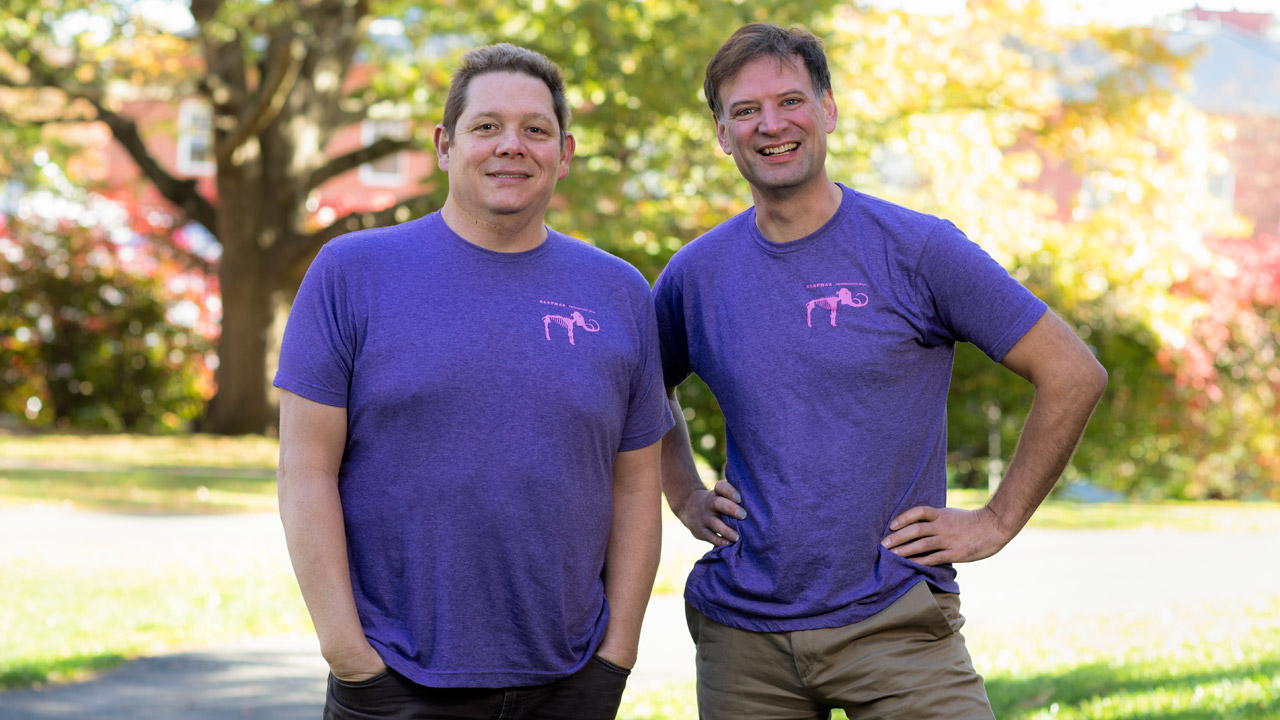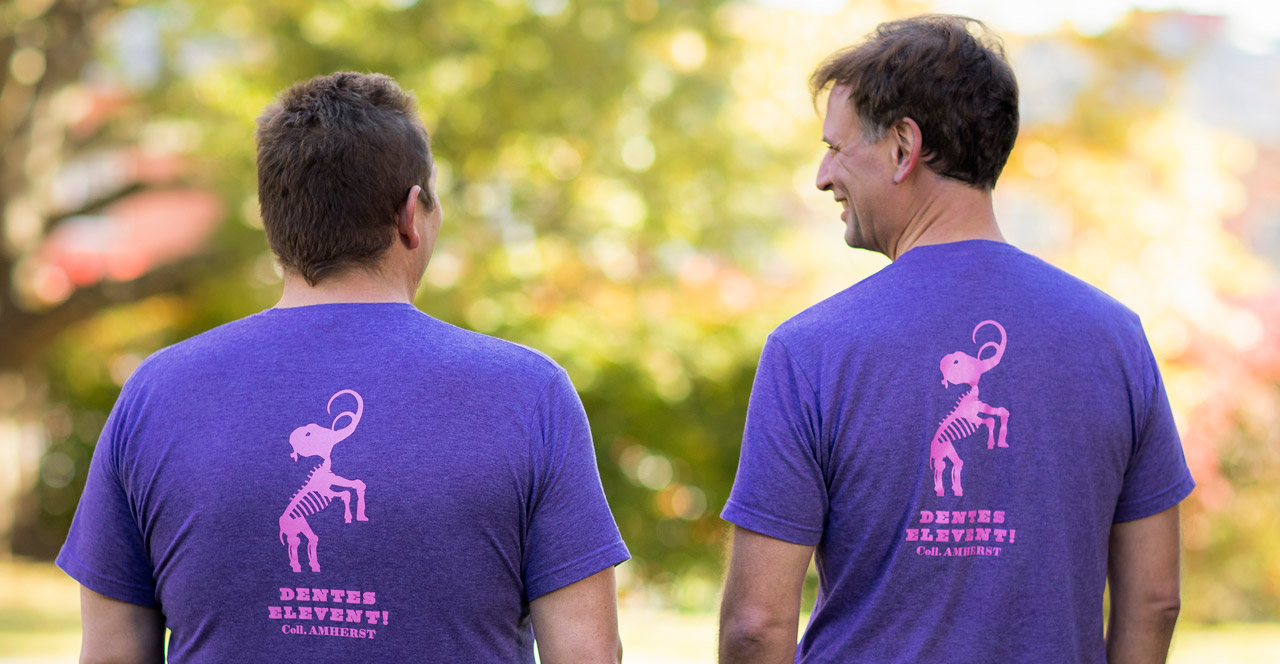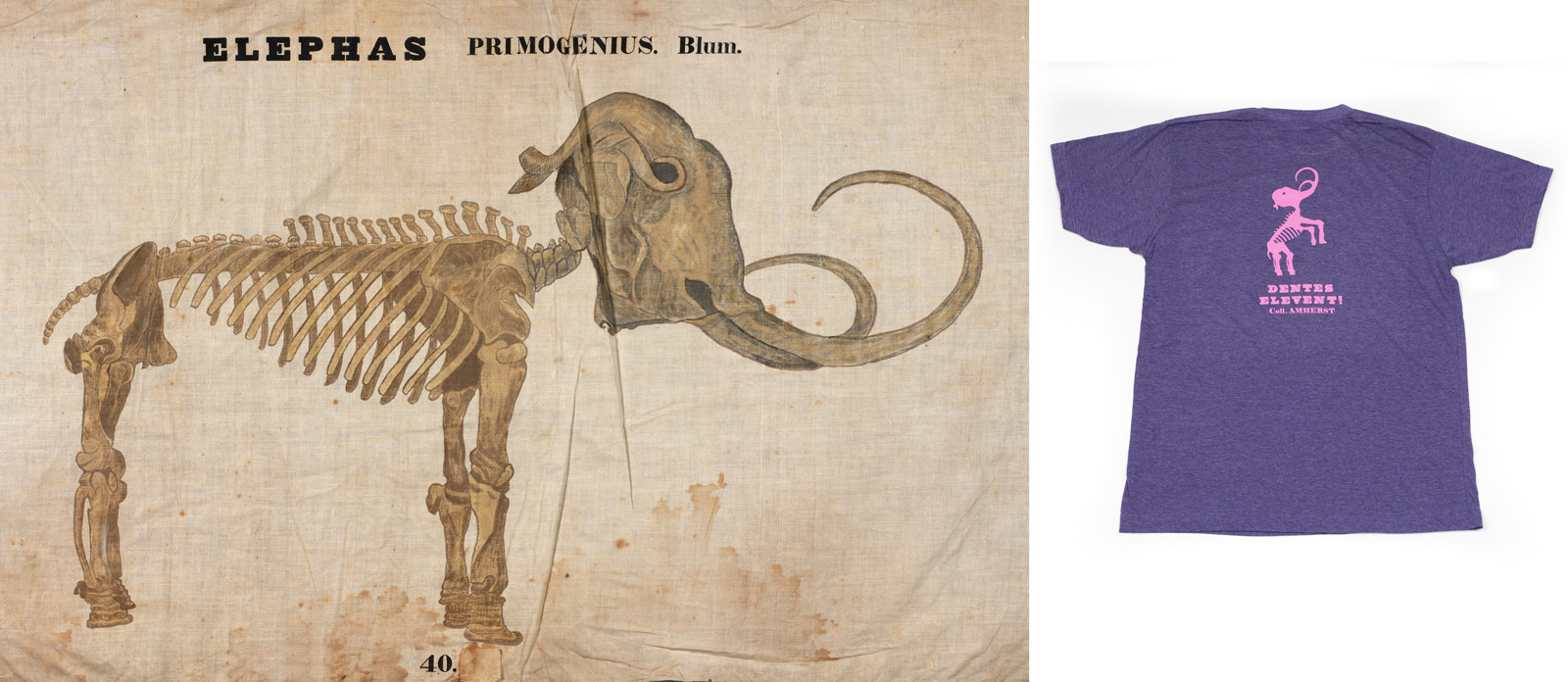
Classics professors Christopher van den Berg and Andreas “Tom” Zanker
If you’re someone who likes to urge, with gusto, Carpe diem! or, more warningly, Caveat emptor! or say, cheerfully, Bonus! (it’s Latin for “good”) then you’ll appreciate this new Latin coinage:
Dentes Elevent!
It means “Tusks Up!” — a rallying cry that has stomped into great popularity since the Mammoth became the College’s mascot in 2017. It’s pronounced “den-tays ay-luh-went”:
Two Amherst classics professors hashed out the translation for a new vintage merchandise line created for Amherst’s Bicentennial.
The line is inspired by objects in the College’s Archives and Special Collections. It offers up 1920s-style football posters; tote bags stamped with arty covers of old student literary magazines; stickers and pins; and a hoodie designed like the Johnson Chapel doors.

The line also includes a Dentes Elevent! T-shirt featuring a decidedly vintage mammoth. It was drawn by the 19th-century artist Orra White Hitchcock for class use by her geologist husband, Edward Hitchcock, the College’s third president. The American Folk Art Museum gave her a show a few years back. One critic admiringly dubbed her work “educational posters on acid.”
Hitchcock labeled her mammoth (in somewhat shaky Latin) elefas primogenius, which means “first-born elephant.” Which brings us to the tricky task of applying an ancient language to modern use. It involves problem-solving, paying attention to nuance and lots of thoughtful discussion—a process that struck me as a good microcosm of the Amherst experience.
So I reached out to those classics professors—Andreas “Tom” Zanker and Christopher van den Berg—to find out how they battened down the Latin. They’ve had weirder queries, by the way: Each has been consulted, out of the blue, by folks getting tattoos in Latin who wanted to get the grammar right.
The first challenge, the two explained, was that the Romans had never actually seen a mammoth (or mammoth skeleton)—so they had no word for it. The late-empire Romans became brutally familiar with elephants, however, when invaders (Pyrrhus followed by Hannibal) deployed them in battle starting in 280 BCE.
Confronted with this bizarre new creature, the Romans called it a “Lucanian cow,” named for the area in southern Italy where that first confrontation took place. Later, the Romans borrowed elephantus from the Greek elephas, which may stem from a similar Phoenician word. For a while, elephantus did double duty: it meant both ivory and elephant.
The Romans had seen tusks before, and probably surmised that the elephant’s ivory was a grander version of what’s found on wild boars roaming the Roman countryside, adds Zanker.
And so to that first word of Dentes Elevent! When the Romans looked at the elephant’s tusk, “they figured out what word they could use for it,” says Zanker. “And the one that springs to mind, I guess, was tooth. The word dental, for example, comes from the word dens, which means tooth, but it can also mean tusk. So when you’re going to the dental clinic, you going to the tusk clinic as well.”

Drawing by Orra White Hitchcock
Back at our own “Tusks Up!” clinic, the two Latinists walked me through their phases of phraseology. Dentes elevate! (“Raise your tusks!”) was a contender, and worked well since the verb is in the plural, with the speaker addressing a group (or herd) or the bleachers at Pratt Field, for that matter. But they feared folks would pronounce it like the English “elevate” rather than the correct “el-uh-watt-ay.”
Dentes levate! would have also done, though on first glance it seems to ask the impossible (“Levitate your teeth!). Dentibus elevatis! (“With tusks uplifted!”) was accurate, too but it’s a Latin construction called an ablative absolute, and isn’t as commanding as the others.
How to choose? An impromptu (that’s Latin for “in readiness”) student focus group helped out. I spoke to one participant, Leland Culver ’24, who took Latin in high school and an Amherst course on the poet Catullus. Culver says the students thought “Dentes Elevate was kind of doofy. It looked like Teeth Elevate!— which was a little weird.”
Culver isn’t the first to note the perils of a bad guess. Out at a New Haven bar in 1946, an Amherst student asked a bunch of Yalies if they thought their Latin education was worthy. Could they translate Amherst’s motto, Terras Irradient? One paused, thought a bit. Then he ventured: “Shiny dirt?”
In the end, van den Berg proposed Dentes elevent (“Let them raise their tusks!”) which has a nice parallel to Terras irradient (“Let them illuminate the lands!”).
So Tusks Up, Mammoths! Dentes elevent! Put your heart into it. Your teeth, too.
